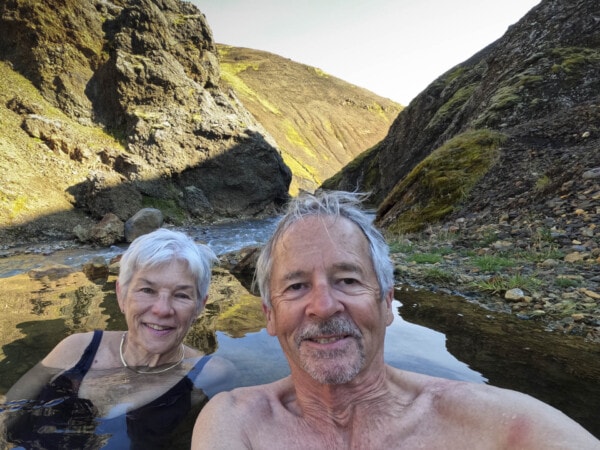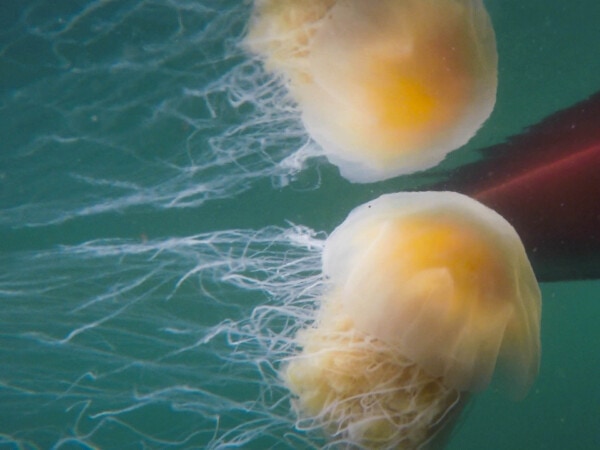Hveradalir was the main reason we rented a 4×4 in Iceland—you need one to reach this geothermal wonderland in the Central Highlands, one of most active volcano systems in the land of fire and ice. Photographers and hikers are drawn to this remote landscape—one of the last, great, wilderness spots in Europe. From the moment we saw photos of its otherworldly majesty, we knew it was going to be a highlight of our trip.
Dominating the unique scenery are barren mountains of rhyolite the colour of burnished copper.
White plumes steam from the fumaroles of mini volcanoes.
Near the vents, the ground is scarred a sulphurous yellow.
Active geysers spew the air with rainbow fountains of water, and numerous hot springs colour the ground red, green and yellow.
Lining the trail are pools of mud the colour of ancient clay vases.
In spots, there are daubs of bright green vegetation.
A river of blue carves its way around the valleys and in the distance, mountains of black lava stand in sharp contrasted to glacier patches of stark white.
Where do you point your camera?
On a four-kilometre loop, our hiking speed dropped to less than half our normal average. Good thing we didn’t hike the three-day, forty-seven-kilometre circuit, because at that pace, we’d have had to hike for eighteen hours a day!
Kerlingarfjöll is one of Iceland’s most incredible natural wonders, a 10,000-year-old mountain range formed by a rare volcanic activity—lava erupting through glacier ice. Located in the zone where the North Atlantic and Eurasian tectonic hot plates are drifting apart, it’s basically one big caldera, the massif of rhyolite intersected by steaming gullies and valleys, the river Innri-Ásgarðsá running through the boiling geothermal area. In 2017, the 367-square kilometre Kerlingarfjöll area was declared a protected nature reserve.
Kerlingarfjöll is accessible only by driving on F roads.
Not that F; it just means the roads are remote, often closed in winter, gravelled, and have the possibility of massive potholes, tricky river crossings and the sudden onset of bad weather.
From Geysir, it was 10 kilometres of asphalt and then 60 kilometres of hard-packed gravel on the F35. Turning onto the F347, it was 15 kilometres of soft-roading to the the Kerlingarfjöll Mountain Resort followed by 5 kilometres of steep uphill on a single-track road, including a small stream crossing. Although this section isn’t technical, it’s visually intimidating, so many hikers chose to walk rather than drive to the trailhead. This last section is where the scenery changes from barren to beautiful. As you climb up to the Blafell Pass, the other side opens onto grand views: the Langjokull glacier in the west, the Hofsjokull glacier in the east.
When we reached the Neðri-Hveradalir parking area, the number of hiking options made it somewhat confusing as to where to go. Although the steep and slippery-looking start looked a bit freaky, we decided to do a counter-clockwise loop.
The clay-rich ground here is unstable and sticks to your boots like an orangey-brown cement.
Signage warns you to stay on the marked trails.
A careless step on the thin crust and your foot is in boiling hot water and severely burned, which a writer imagined would be like “your skin rolling off your foot like pantyhose!”
The highest surface temperature in Iceland was recorded at the Hverabotn geothermal area further on—150°C—temperatures 1000 meters below surface have measured at a hellish 200°C.
The air temperature was about 9°C when we started hiking but four hours later it had climbed to 16°C, hot for this time of the year in Iceland.
Wooden steps in the steep and narrow parts made the climb easier. And after the first ascent, the trail was moderate, our breath taken away only by the 360° views—epic—and our favourite hike in Iceland for sure.
It comes as a surprise to some but there are no hot springs in the Hveradalir area to bathe in.
For that, we had to go back to the Kerlingarfjöll Mountain Resort. I had inquired about staying but they were closed and building a new hotel. A construction worker told us how to find the trail to the Kerlingarfjöll Hot Springs, about 1.5 kilometers from the hotel.
Following a small river through the valley, the narrow trail was originally used by workers as a pathway to a spot in the river they were testing to see if it was hot enough use as a heat source for the resort. They were repeating the drill tests when we were there.
Three young men happy to show their pecs and a family of middle-aged Italians practically filled the small geothermal pool, which accommodates about a dozen people. There’s a platform and bench where, if you’re discrete, you can strip down and get into your bathing suit without being seen. The water temperature of the hot springs is around 35°C. For a brief while we had the pool to ourselves before a young Icelandic couple backpacking a small child arrived. If we could speak their language, we’d have said, “Hvað er heitur dagur ha?“
What a hot day eh?

















6 Responses
That was an interesting site. Natural hot springs are a favorite of ours too.
Seeing an active volcano is still on my bucket list. Maybe one will flair up in Iceland, there are some cheap fares from Detroit.
Your chances are good: 20-25 events per 100 years they say. We were going to go see Fagradalsfjall volcano but it petered out a week or so before we left home.
Nothing like a Hot soak in a natural pool to get the kinks out of an abused body following any type of hard physical activity.
Have a few favourites around BC but not as hot as your Icelandic hot spot, still beyond soothing when you need it most.
Interesting landscape in the area, the short video gives you a very good idea of just how hot the area is.
Seems to be a great interest in Iceland as of late, seems to pop up a lot lately making your stories spot on for those interested in the area.
Great job,
Iceland was expecting 1.2 million tourists in 2022, almost as many as the record set in 2018. But get this: they’re expecting 2.3 million this year! And 3.5 million by 2030. For good reason, it’s a great place to visit.
Such a contrast—wearing a parka and a bathing suit, although I remember scurrying to the pool as the afternoon sun started to drop. We cannot speak a word of Icelandic and there is little incentive as the Icelandic people we met spoke perfect English. ( I used Google for “What a hot day, eh?”)
Amazing contrast of snow and steam with boiling water. A soak in the hot springs looked very comforting after or during a hike like that one.
Were you able to learn to speak a bit of the language?